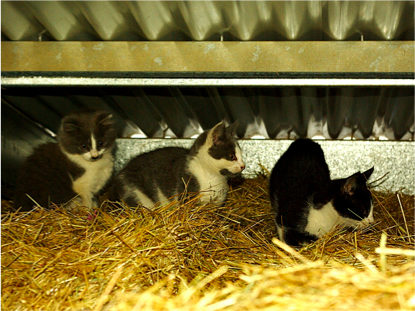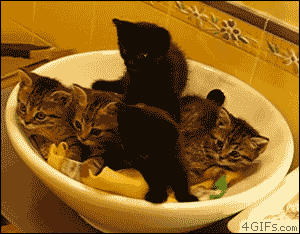How Many Feral Kittens?
A clowder of feral cats is living under the shed behind your home. One of them appeared pretty pregnant, and you've heard mewing lately so you figure there must be a litter of new kittens. The problem is that you don't know how many kittens there are in that litter.

A few weeks go by, and you start to occasionally see kittens wander out from under the shed, play around, and then go back under. You do some serious reading on feral cats and kittens and collect the following starting information about the litter:
- There is only one litter.
- The litter either has 3, 4, or 5 kittens, all with equal probability of occuring. There is no other possible litter size.
- The kittens exist in two states: under the shed or visible.
- The kittens function on a highly structured schedule, changing their state only every hour
- In any given hour period, each kitten will venture out from underneath the shed with an independent probability of 0.5. If it ventures out, the kitten will play outside for the entire hour either by itself or with other kittens before returning inside at the end of the hour
- The decision made by each kitten to be outside or under the shed is made independent of previous states.
- The kittens are indistinguishable to you. All you can do is count the number of kittens outside during a given hour period.
Part 0: The Zeroth Hour
What is the starting distribution of the kitten litter size, `Pr(L)`? Fill in the probability for each Litter Size (`L`) to six significant places. The solution boxes will accept Python numerical expressions so feel free to enter your computations into them. (for example either 0.1666667 or 1/6 is valid)|
|
|
|
|
|
|
|
At this point in our analysis, what is the expected number of kittens in the litter?
The expectation of a random variable X that ranges over numerical value is written E[X] and is defined as
If there were actually 4 kittens, what would the distribution over the number of kittens to appear outside for the next hour be? Provide a distribution in the form of a Python dictionary (so, for example, {100 : 0.5, 150 : 0.5} would mean there is a 0.5 chance of there being 100 kittens and a 0.5 chance of there being 150).
What is the expected number of kittens to appear outside for the next hour?
Part 1: The First Hour
You call in sick at work in order to stay home and watch the kittens. You start your clock and observe only one kitten playing outside during the first hour. With this new information, fill in the probability for each Litter Size (`L`) to six significant places.|
|
|
|
|
|
|
|
Part 2: The Second Hour
During the second hour, you observe no (0) kittens playing outside. With this new information, fill in the current probability for each Litter Size (`L`) to six significant places.|
|
|
|
|
|
|
|
Part 3: The Third Hour
During the third hour, you observe four (4) kittens playing outside. With this new information, fill in the current probability for each Litter Size (`L`) to six significant places.|
|
|
|
|
|
|
|
Part 4: Looking Forward
Using Litter Size probabilities in the previous table, what is the expected number of kittens that you will observe in the next hour? Answer to six significant places.